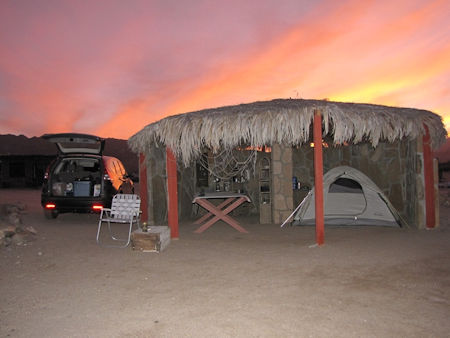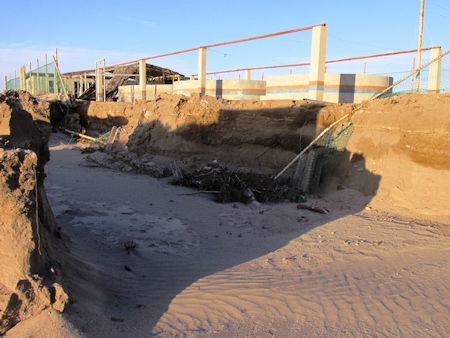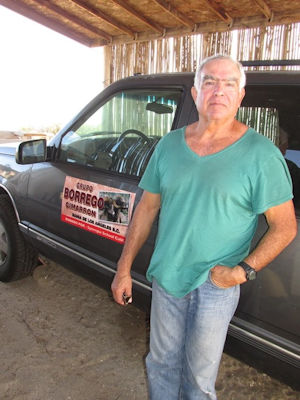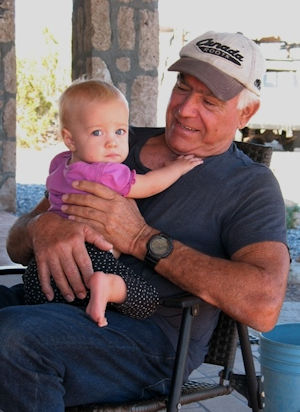 |  |

I first visited the Sea Turtle Research Station in Bahía de los Ángeles in the summer of 1983. I kayaked over there from just south of town in the company of Mountain Mike (Mike Michel) who kept a second home in a cave atop the mountain overlooking the town. We saw the turtles in their large circular concrete tanks but unfortunately there was no one around to speak to.
Over the years, I got to revisit the turtle facility scores of times, and spoke often to Antonio Resendiz, who was in charge. Indeed, the adjoining campsite – Campo Archelon – is one of my favorite camping areas in all of Baja.
Quiet, with sturdy palapas right on the beach, well run and friendly… it was a natural magnet for those with a passion for nature and conservation. My wife was a guest there and a friend of Antonio before I met her. Our two children camped there several times growing up. Like many others, they experienced the fun and joy of feeding and cleaning - and learning about - the turtles.
Antonio was affectionately known to many tourists as Tony. His energy and interests were incredible: environmentalist, political advocate, educator, camp host… but above all, scientist and researcher.
Born and raised in Mexico City, Tony studied Oceanography at UABC in Ensenada. He moved to LA Bay almost forty years ago, at age 24, when he took responsibility for a government turtle research and conservation project that had been set up in 1978. Its original goal was to care for undersized animals, and rehabilitate turtles found injured in nets.

Bahía de los Ángeles was destined to be his home and passion for the rest of his life. Living and working with local fishermen who prized turtle meat took considerable patience, tact and courage, especially when turtle fishing became illegal. Seizure of illegally caught turtles had serious implications and could easily lead to community tension and violence.
Education and persuasion was his forte, as well as empathy for the poor fishermen who were desperately trying to make a living. His ire was directed at corrupt politicians and the arrogance and indifference of a political system that skimmed away wealth without a thought for the poor or the environment.
In 1988 he began working with Beatrice (Bety) Jimenez, a biologist and graduate of the University of Michoacán. Before arriving in Bahía she had worked for four years in turtle conservation and nest protection in that state. They eventually married and had two children, Antonio and Alejandra.
Tony and Bety’s work together broadened into documenting and protecting all Bahía’s marine and bird resources. But turtles were their primary focus, especially loggerheads - the most abundant species around the coast of Baja.

As well as keeping hawksbills, leatherbacks and greens, several loggerheads were nurtured, cleaned, weighed and studied over many years spent in the tanks. Blood samples were drawn, genetic comparisons were made.
Most of the loggerheads seen feeding in the rich waters around Baja were juveniles and young adults. Pelagic red crabs were a major part of their diet, but the rest of their life-cycle was a mystery. Where were they nesting? There was no evidence they were coming ashore to lay their eggs anywhere in the Americas.
Genetic information from Tony’s Baja-caught turtles suggested the population was closely akin to loggerheads from Japanese waters. But it seemed incredible to think that juvenile loggerhead turtles were instinctively making a 6000-mile migration across the Pacific, through vast tracts of clear ocean with minimal feeding opportunities, to feed in Mexican waters, and then back the same distance 10-30 years later as mature adults.
To test this theory, on July 19, 1994, Rosita, a female loggerhead from the Sea Turtle Research Station was tagged and released in the Pacific off Santa Rosalillita. Rosita had been studied in captivity since July 1986. She weighed about 13 lbs. when brought in, and over 200 lbs. when released.
Sixteen months later, in November 1995, Rosita was dragged up dead in a fisherman’s net off the Japanese island of Kyushu.

There was naturally sadness that Rosita had not survived, but eye on the big picture, Tony was excited and ecstatic. It was seemingly conclusive evidence that loggerheads in the Northern Pacific did indeed make a transpacific migration, one of the longest of any marine animal.
Tony went with Bety to Japan to meet the fisherman who had returned the tag, and to help drive home the importance of Japanese beaches to the survival of the loggerhead turtle. The implication was clear: conservation efforts in the Americas were futile without ensuring that the nesting beaches in Southern Japan were protected.
To further test the theory, Adelita, another of Campo Archelon’s 200 lb. female loggerheads was released in the Santa Rosalillita area on August 10, 1996, this time with a satellite tracking device attached to her shell. She had been brought to the Research Station in 1986 weighing just 9 lbs. and had been ten years in captivity. For just over a year, thousands of students and individuals followed the big girl’s transpacific route all the way to the Japanese coast, where Adelita disappeared, almost certainly falling victim to another net.
Tony and Bety moved on from running the Research Station a few years ago, and it was shortly afterwards decommissioned. The old tanks and workshops were almost undermined and washed away by Hurricane Odile in 2014.
Running Campo Archelon as an ecotourist and educational center… and seeking other ways to help the Bahía community with sustainable projects became Tony’s new focus.
One of his last was employing local guides and ranchers to create watering holes and take tourists to the nearby sierras to photograph, rather than shoot, bighorn sheep – borregos.

Earnest and passionate, yet kind, considerate, and a wonderful listener… well-read and knowledgeable in so many spheres, but always eager to learn more, Tony was a truly exceptional human being. He watched his brothers pass away and felt sure his time was limited. Perhaps that explains his energy and drive.
He touched so many lives, including mine. Tony arranged a panguero to take me to Guardian Angel Island, where I spent two months in 2006, and introduced me to so many people knowledgeable about the island to help with my research and writing.
Marooned With Very Little Beer, my last book, emerged from that sojourn. It was heavily shaped by Tony’s guidance and advice, and would have been a thinner, poorer book without the information and contacts he provided.
Thus, I was shocked and saddened to hear of his sudden passing in LA Bay this March at age 61. To me and many others, Bahía will never be quite the same.
The last picture I took of Tony, in November 2015, shows him holding and delighting in a young child. It seemed appropriate… Antonio Resendiz worked tirelessly as scientist and educator, but he was determined to preserve and pass to future generations all the breathtaking beauty and wonders that he had found there at Bahía de los Ángeles.
Adios amigo. RIP. I know I’ll feel your energy and spirit every time I gaze at that awesome bay that you and Bety made your home.
About Graham
Graham is the author of four books on Baja California including Nearer My Dog to Thee which describes a four-month sojourn in the Sierra San Pedro Mártir with two adopted street dogs.
Details on all Graham’s books can be found on his website: www.grahammackintosh.com

Very knowledgeable and helpful.

Easy to work with!!!!!

I've been a Baja Bound Insurance customer since 2006! They're the absolute best. #slowbajaapproved